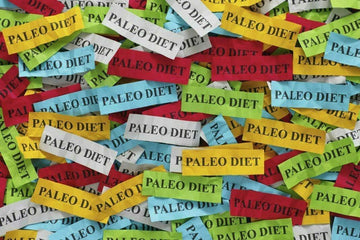Paleo - A synonym for well-being and performance
Paleo is a diet that helps you lose weight and live a healthy, active life.
In this article, we present you with the most important basic knowledge and valuable tips that will help you change your diet to Paleo without starving or experiencing the famous yo-yo effect. What does Paleo mean?
Paleo refers to a diet that is based on the Old Stone Age, the Paleolithic period, which is why it is also called the “Stone Age diet” or “Stone Age diet”.
Paleo is based on the principles of hunters and gatherers of the past, whose eating habits are imitated with the corresponding foods of today. The focus of this diet is on high-quality food and sustainability. The foods that have been used in modified form by the human species since the beginning of evolution, which lasted around 2.5 million years, are the central pillars. They provide our organism with an optimal supply of all important nutrients.
Paleo and its main components
The Stone Age diet consists exclusively of natural, unprocessed foods that are rich in nutrients.
These include:
-Fruit and vegetables
-Fish and meat
-Eggs
-Seeds and nuts and
-all healthy fats
Forbidden foods of the Paleo diet
Since Paleo is a Stone Age diet, processed foods that were only available about 10,000 years ago, with the advent of agriculture, are undesirable, as are those that contain an increased amount of antinutrients, as these are harmful to the human organism.
These include:
-Cereal products and pulses
-Dairy products
-Sugar
-processed, low-quality vegetable fats and
-all artificial additives
The Paleo food pyramid gives you a detailed overview as well as valuable background information on the individual food groups and Paleo foods.
Start the 30-day Paleo Challenge now!
Paleo and its benefits
Because the Paleo diet harmonizes with our genes, it is the ideal diet for many.
Paleo helps people to stay healthy, at an ideal weight and fit because their bodies have adapted to the foods of this nutritional concept over the course of evolution.
The Western diet, which, in terms of overall historical development, emerged only recently, is primarily responsible for the growing number of serious illnesses, including cardiovascular problems, cancer, diabetes, obesity, autoimmune diseases and depression. This is due to the use of sugar, highly processed foods and inadequate fats.
Readers of our blog www.paleo360.de also describe their positive experiences with switching to the Paleo diet. They particularly emphasize a good general well-being and health, which includes the following factors:
-intact immune system
-optimal blood sugar levels
-healthy digestion
-normal blood pressure
-increased physical and mental performance
-relaxed sleep
-healthy hair and more beautiful skin
-sustainable weight reduction
-increased fitness and stronger muscles
-increased concentration
-less depression and therefore a happier mood
-Reduction of allergy symptoms and inflammation as well as
-improved respiratory function in asthmatics.
Through these testimonials, you too can get an idea of the successes that are possible with Paleo.
Paleo is more than just a “Stone Age diet”
In order to live according to the nutritional principles of the Paleolithic era, no one has to give up their comfortable standard of living. Rather, the focus of Paleo is on knowing which foods are healthy for our bodies, relying on well-known nutritional theories and combining them with today's scientific findings.
In principle, not everyone can fully integrate this nutritional concept into their everyday life, but it is recommended to complete a 30-day phase in which the Paleo guidelines are followed without exception in order to encourage a corresponding change in diet and experience the full success.
Our 30-day challenge will help you with this.
In the long term, however, it is advisable to add certain foods, including high-quality (raw) dairy products, back into the diet.
Further steps of the Paleo diet
After our brief presentation of this nutritional concept, you probably have a certain idea of what the term Paleo means and how it works. To ensure that you always receive the most up-to-date, interesting information about Paleo in the future, you should definitely subscribe to our newsletter, which you can find in the large orange box at the top right.
Now we don’t want to explain the theory to you any longer, but advise you to simply get involved in the Paleo diet.
The Paleo Principle for Practitioners
Do you want to start giving your body more vitality with Paleo? Then start the 30-day challenge now!
If you need support or further information, you can find it on our website. This may make it easier for you to get started, although of course this is only a guide and not a prerequisite for Paleo.
Our cookbook, with 115 delicious recipes and an introduction to Paleo, may also offer you added value, or you can use our "savings package" and its recipe magazine for the inspiration you need for your meal plans. This not only contains the 30-day challenge and information material, but also seasonal plans for each month, delicious recipe ideas, useful information for Paleo professionals and many other advantages. You can also use our recipe finder. This provides you with all of our recipe suggestions, either unsorted or grouped into categories. You are guaranteed to always find the right dish for a delicious menu.
The Paleo Diet for Theorists
If you still haven't received enough information, the following articles will certainly give you a specific overview of Paleo. If this isn't enough, you are welcome to visit our blog, which is full of exciting, valuable information. We are firmly convinced that it will help you to clarify any remaining questions.
So you can soon start your 30-day Paleo challenge towards a healthy future.





